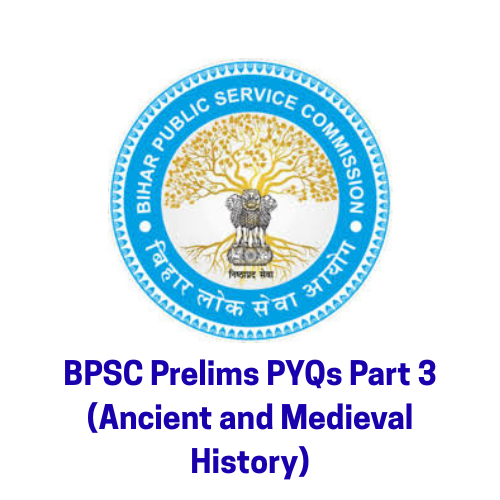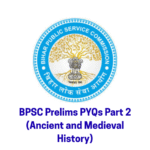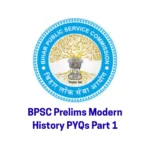Ancient and Medieval History forms an important segment of BPSC Prelims PYQs Part 3. These questions generally cover facts, significant rulers, dynasties, cultural achievements, and landmark events. In the Medieval section, topics frequently asked include the Delhi Sultanate, Mughal administration, regional powers, Bhakti and Sufi traditions, developments in art and architecture, and governance systems. Bihar’s medieval legacy, especially the role of Sher Shah Suri, is a recurring theme in the exam.
BPSC Prelims PYQs Part 3
Q1.The word “Bronze” is associated with
(a) Gold
(b) Copper and Tin
(c) Silver
(d) Lead
(e) None of the above/More than one of the above
Ans. (b)
Q2.The term “Ghazi” was first used by which ruler?
(a) Humayun
(b) Akbar
(c) Babur
(d) Jahangir
(e) None of the above/More than one of the above
Ans. (c)
Q3.The ruins of Vijayanagara are found at
(a) Bijapur
(b) Golconda
(c) Hampi
(d) Baroda
(e) None of the above/More than one of the above
Ans. (c)
Q4.Who was the first Muslim ruler to formulate the “theory of kingship”, similar to the “theory of divine right of the kings”?
(a) Aibak
(b) Iltutmish
(c) Balban
(d) Alauddin
(e) None of the above/More than one of the above
Ans. (c)
Q5.European paintings were introduced in the court of
(a) Humayun
(b) Akbar
(c) Jahangir
(d) Shah Jahan
(e) None of the above/More than one of the above
Ans. (b)
Ancient and Medieval History PYQs
Q6.Chinese traveller “Sungyun” came to India in
(a) 515 AD to 520 AD
(b) 525 AD to 529 AD
(c) 545 AD to 552 AD
(d) 592 AD to 597 AD
(e) None of the above/More than one of the above
Ans. (a)
Q7.At which of the following Harrapan site, terracotta model of “plough” was found?
(a) Dholavira
(b) Banawali
(c) Kalibangan
(d) Lothal
(e) None of the above/More than one of the above
Ans. (b)
Q8.Kaling’s King Kharvela was associated with
(a) Chedi Dynasty
(b) Mahameghavahana Dynasty
(c) Satavahana Dynasty
(d) Rath-Bhojak Dynasty
(e) None of the above/More than one of the above
Ans. (a)
Q9.“Diwan-E-Arz” department was associated with
(a) Royal Correspondence
(b) Foreign
(c) Defence
(d) Finance
(e) None of the above/More than one of the above
Ans. (c)
Q10.Which type of land was called “Aprahat”?
(a) Forest land
(b) Irrigated land
(c) Without cultivated forest land
(d) Cultivated land
(e) None of the above/More than one of the above
Ans. (c)
BPSC Prelims PYQs Part 3 (Q11 to 20)
Q11.“Jaswant and Dasawan” famous painters were courtier of Mughal emperor
(a) Humayun
(b) Akbar
(c) Jahangir
(d) Shah Jahan
(e) None of the above/More than one of the above
Ans. (b)
Q12.Who was the founder of Bahamani Kingdom?
(a) Firuz Shah
(b) Ahmed Shah
(c) Alauddin Hasan
(d) Mahmud Gawan
(e) None of the above/More than one of the above
Ans. (c)
Q13.Which among the following King’s reign Persian traveller, “Abdur Razzak,” came to India?
(a) Dev Raya I
(b) Harihara I
(c) Krishnadeva Raya
(d) Dev Raya II
(e) None of the above/More than one of the above
Ans. (d)
Q14.Who among the following was not associated with the excavation of Harappa and Mohenjodaro?
(a) R.D. Banerjee
(b) K.N. Dikshit
(c) M.S. Vats
(d) V.A Smith
(e) None of the above/More than one of the above
Ans. (d)
Q15.Gautam Buddha gave his first sermon at
(a) Sarnath
(b) Bodh Gaya
(c) Kapilvastu
(d) Kushinagar
(e) None of the above/More than one of the above
Ans. (a)
Ancient and Medieval History PYQs
Q16.Who is called the “Napoleon of Ancient India”?
(a) Chandragupta Maurya
(b) Pushyamitra
(c) Kanishka
(d) Samudragupta
Ans. (d)
Q17.Which Chinese traveller visited India during the Harshavardhana’s rule?
(a) Fa-Hien
(b) Hiuen-Tsang
(c) I-Sting
(d) Taranath
Ans. (b)
Q18.What is “Adhai Din Ka Jhopda?
(a) Mosque
(b) Temple
(c) Saint’s Hut
(d) Tower
Ans. (a)
Q19.In which language was “Tuzuk-i-Baburi” written?
(a) Persian
(b) Arabic
(c) Turkish
(d) Urdu
Ans. (c)
Q20.Who was the commander of Rana Pratap’s army in the Battle of Haldighati?
(a) Amar Singh
(b) Man Singh
(c) Hakim Khan
(d) Shakti Singh
Ans. (c)
BPSC Prelims PYQs Part 3 (Q21 to 30)
Q21.Where was the capital of Shivaji?
(a) Raigarh
(b) Sindhudurg
(c) Poona
(d) Kolhapur
Ans. (a)
Q22.Who was the author of Indica?
(a) Vishnugupta
(b) Megasthenes
(c) Diamechus
(d) Pliny
Ans. (b)
Q23.Which of the following is a Harrapan Port?
(a) Alexandria
(b) Lothal
(c) Mahasthangarh
(d) Nagapattanam
Ans. (b)
Q24.The Gupta emperor who defeated the “Hunas” was
(a) Samudragupta
(b) Chandragupta II
(c) Skandagupta
(d) Ramagupta
Ans. (c)
Q25.What is the name of Kalhana’s book?
(a) Arthashastra
(b) Indica
(c) Purana
(d) Rajtarangini
Ans. (d)
Ancient and Medieval History PYQs
Q26.Which inscription tells about the various achievements of Rudradaman I?
(a) Junagarh
(b) Bhitari
(c) Nasik
(d) Sanchi
Ans. (a)
Q27.Who was the first ruler of the Slave dynasty?
(a) Qutubuddin Aibak
(b) Iltutmish
(c) Razia
(d) Balban
Ans. (a)
Q28.Who was the ruler of Devagiri at the time of Alauddin Khilji’s invasion?
(a) Prataprudra Dev
(b) Ramachandra Dev
(c) Mailk Kafoor
(d) Raja Ratan Singh
Ans. (b)
Q29.Who among the following Muslim rulers abolished the “Pilgrimage Tax”?
(a) Bahalol Lodi
(b) Sher Shah
(c) Humayun
(d) Akbar
Ans. (d)
Q30.What was “Dar-ul-Shafa” established by Firoz Tughlaq?
(a) An alms house
(b) A free hospital
(c) A library
(d) A guest house for pilgrims.
Ans. (b)
BPSC Prelims PYQs Part 1 (Q31 to 39)
Q31.Where did Mahatma Buddha gave his first “Dharma Chakrapravartana”?
(a) Lumbini
(b) Sarnath
(c) Pataliputra
(d) Vaishali
Ans. (b)
Q32.Where did Mahatma Buddha’s Mahaparinirvana take place?
(a) Lumbini
(b) Bodh Gaya
(c) Kushinara
(d) Kapilavastu.
Ans. (c)
Q33.What was the name of the dynasty of Ajatshatru?
(a) Maurya
(b) Haryanka
(c) Nanda
(d) Gupta
Ans. (b)
Q34.In how many adhikarnas is the Kautilya’s Arthashastra divided?
(a) 11
(b) 12
(c) 14
(d) 15
Ans. (d)
Q35.Who identified the name “Sandrokottas” as Chandragupta Maurya?
(a) William Jones
(b) V.A Smith
(c) R.K Mukherjee
(d) D.R Bhandarkar
Ans. (a)
Q36.Who deciphered the Brahmi inscriptions of Ashoka first time?
(a) James Prinsep
(b) H.D Sankalia
(c) S.R Goyal
(d) V.N Mishra
Ans. (a)
Q37.The last Mauryan Emperor was?
(a) Jalok
(b) Avanti Verma
(c) Nandi Vardhana
(d) Brihadratha
Ans. (d)
Q38.The meaning of word “Bantai” during medieval period was
(a) Religious Tax
(b) System of Calculating revenue
(c) Wealth Tax
(d) Property Tax
Ans. (b)
Q39.When did Humayun first attacked “Chunar fort”?
(a) 1532 AD
(b) 1531 AD
(c) 1533 AD
(d) 1536 AD
Ans. (a)


